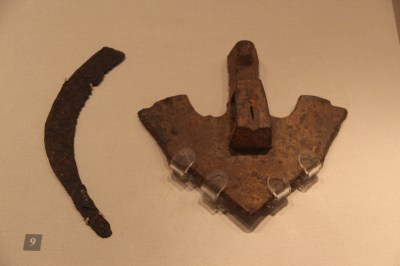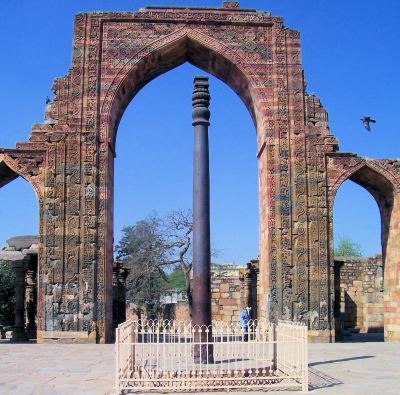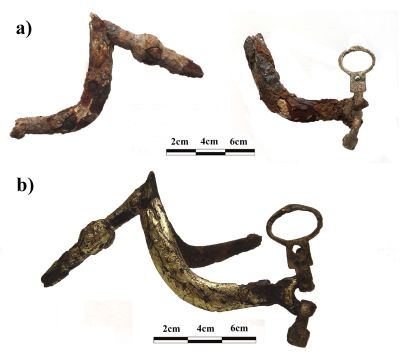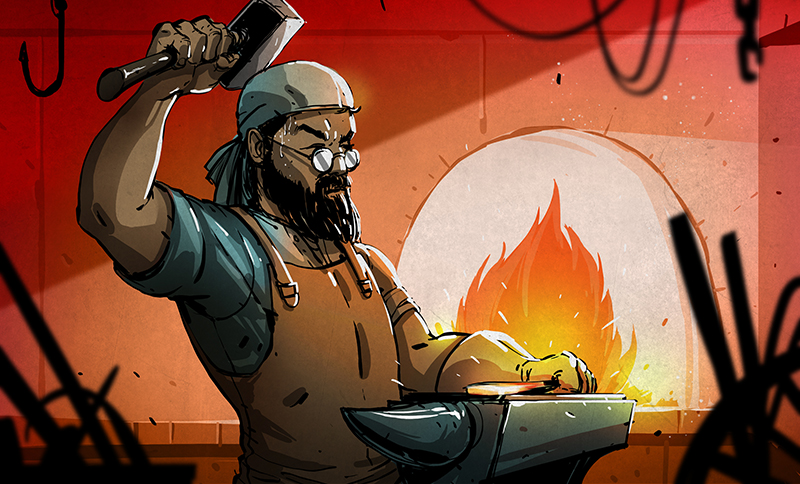When you hear it said that “Modern steel is disposable by design”, your ears perk up, as you just caught the unmistakable sound of faux romanticism along with ‘lost ancient technology‘ vibes. Although it happens sometimes that we did lose something important, as with for example the ancient Roman concrete that turns out to have self-healing properties as a result of so-called hot mixing, this is decidedly an exception.
We nearly lost that technology because of the technological and scientific bonfire that was the prelude to a thousand years of darkness over Europe: called the Dark Ages, Middle Ages as well as the medieval period. Thus when you come across a slideshow video with synthesized monotonal voice-over which makes the bold claim that somehow medieval iron was superior and today’s metallurgy both worse and designed to break, you really have to do a spit-take. The many corrections in the comment section further reinforces the feeling that it’s more slop than fact.
One of the claims made is that the bloomery furnace beats the blast furnace, due to beneficial additives to the iron. Considering that the video cites its sources, it’s at least worthy of a dive into the actual science here. Are modern iron and steel truly that inferior and disposable?
The Iron Age

The Iron Age is defined as the point when a civilization begins to mass-produce tools and weapons made from processed iron ore rather than just the use of found meteoric iron. What makes this such a telling technological moment is because in order to smelt iron, you need to have a furnace capable of generating temperatures around 1,250 °C. The transition between the easier to process bronze and superior iron took place between 1,200 and 1,100 BCE in Europe, along with much of Asia, in particular India and China.
Processing iron ore to turn it into any of the types of iron alloys possible can be done in a variety of ways, with direct reduction through smelting commonly being used throughout history, alongside blast furnaces. These latter became the most common approach in the 20th century, using a two-stage process involving refining in a converter. Electric arc furnaces can take both the pig iron from blast furnaces and scrap metal as input. Regardless of the method used, the iron ore has to have its impurities removed or reduced to the desired levels for the target alloy.

Pig iron is the output of blast furnaces and can be used for cast iron when melted. This is different from the wrought iron, which traditionally was produced using the output from a bloomery. This is a type of metallurgical furnace capable of smelting iron ore. Using direct reduction with a reduction gas like carbon monoxide, methane or hydrogen, it produces direct reduced iron, also called sponge iron, with the intended reduction in carbon content. This can then be processed by a blacksmith into wrought iron products.
Blast furnaces also provide this carbon reduction, using coke or hydrogen as the redox agent, but as a continuous process the resulting pig iron has a carbon content of 3.8 – 4.7% compared to the higher purity of direct reduced iron that puts it on the level of scrap steel.
Currently blast furnaces and electric arc furnaces offer the most economical way to produce large amounts of steel. Modern direct reduction furnace types have been developed that while not directly competitive have certain advantages, such as being able to process certain ore types that blast furnaces struggle with.
That said, China in particular focused significantly on blast furnaces, with no significant use of bloomeries, but instead the use of finery forges to refine the pig iron from their blast furnaces. By using water power, the blast furnaces could produce massive amounts of pig iron, giving China a significant advantage over medieval Europe.
Archaeometallurgy

So how did medieval iron alloys differ from that during the early days of the Iron Age in Europe and China, never mind during the technological boom of the ancient Roman Empire? Unsurprisingly the Early Middle Ages (500 – 1000 CE) saw mostly a sharp decline in mining and metallurgy that took until the High Middle Ages (11th to 13th centuries) to begin to recover and the Late Middle Ages to see a strong push for innovation. This was however not an easy period, as famine, war and pestilence kept ravaging economies and its people. Compared to the relative peace and structured society of the Roman times, things couldn’t have been more different.
The study of metallurgy from a historical context is called archaeometallurgy, which focuses on observable evidence such as slag and similar residues left over at former furnace and blacksmithing sites, as well as found metal artefacts. This latter aspect of found artefacts bears reminding, as these include the iron objects that survived often being buried for hundreds if not thousands of years. This risks indulging in survivorship bias, as we do not recover iron artefacts that did rust away, nor those that were tossed with other scrap metal into a furnace.
The iron pillar of Delhi is one such example. This six-ton, 7.21 m tall behemoth has drawn significant attention for its lack of corrosion despite having been exposed to the elements for more than a thousand years. After study of this pillar and other examples of Indian iron from roughly the same era, the levels of phosphor (P) were implicated in the formation of a corrosion resistant hydrate layer, as summarized in a 2000 article by R. Balasubramaniam in Corrosion Science. This is however a relatively thin and fragile layer. Before a protective cage was added, the constant touching of visitors would affect this layer, explaining why its bottom is rather rusty.
What this does however highlight is the importance of a passivation element in iron alloys to enable some level of corrosion resistance by preventing or slowing down the oxidation process. This, combined with environmental factors such as dry air and a low-oxygen environment can be key to the survival of an iron object.

In the case of modern stainless steel, this passivation is provided primarily by chromium which helps form a protective layer. As pre-Industrial Revolution iron alloys tended to have significant amounts of slag and other contaminants embedded in them, this provided enough opportunities for such a passivation layer to be formed.
A good study subject when it comes to medieval iron can be found in the surviving medieval structures, which are primarily churches and cathedrals. These have iron reinforcements that are exposed to various environments, ranging from an dry indoor climate to ones more conducive to corrosion. In a study of these iron rebars in the 13th century Bourges’ Cathedral attic, including a broken one, it was found that they were decidedly rusting away and that even these primarily indoor rebars need special preservation techniques to keep them from eventually failing.
During an excavation in a medieval necropolis in Spain, a gilded spur was uncovered. This was used for an experimental archaeological analysis method, detailing just how far this gilded, medieval iron object was decayed. While the gold layer provided some protection against corrosion, eventually moisture and oxygen managed to make its way past this layer and over the course of a few hundred years much of the spur decayed to the point where it was largely falling apart.
Modern Age
Although it’s tempting to hold modern day in contempt and indulge in romanticism of a past that never was, the fact of the matter is that these days we have ways to analyze and manipulate iron and other alloys in ways that the ancient Romans and medieval metallurgists could only dream of. While they had extensive institutional knowledge based on empirical findings, we can use methods like Raman spectroscopy to prod molecules to determine their identity and electron microscopes to find out their structure.
Whereas for ancient Roman concrete we can definitely state that it’s better in certain ways than the concrete we have been using since the Industrial Revolution, there we have the hard to miss evidence of Roman concrete structures like ancient seawalls and the Pantheon in Rome seemingly oblivious to the elements and weather of the past two thousand-odd years.
As far as miraculous ancient iron goes, there are definitely a few oddities out there like certain types of Indian iron, and using modern metallurgy we should definitely do our utmost to understand the materials science behind their longevity. That said, modern metallurgy is already pretty good. If your tools are rusting away, or your stainless steel car is taking on a disquieting orange sheen, you probably should have picked that 304 stainless steel instead of cheapening out with a 200-series or 301 stainless steel. We have the technology.
















Keep in mind that Raman spectroscopy was invented by India and it’s one of the most important discoveries. India is one of the biggest and most innovative countries when it comes to inventions and metalworking.
its never a country, but always a individual; somtimes silitair, sometimes in team work. but yeah, india has lots of individuals.
Cope
I found the impostor!
I hit the back button
This is the objectively correct response.
I didn’t wrestle through the whole video, but I had to force myself to watch enough of it to make note of the ‘points’ being made in it.
Could be a way of handling a planet that speaks more than just English.
At this point we should all just decide on whether it’s going to be English or Mandarin. And don’t gaslight me about the “cultural value” of this tower-of-babel nonsense we have now, where no one understands each other. Everyone on earth drives cars and eats hamburgers at this point, the rest is just window dressing.
Sir, this is not a reddit. We don’t caren’t about your sad feeling here.
Some of the steels were amazing for it’s time. But even if you could recreate an ulfberht sword or a katana, you could probably cut it in half with a decently heath threated 80crv2.
I have read a history book that said that vikings added bones while forging. They used, according to some documents, but not proven, bones of their ancestors, thinking it would transfer their souls and make the steel better. That last part was true as bones added carbon. It’s difficult to find out what is real about that time as they didn’t write any books on the subject, that we know of.
Indeed, some truly amazing iron alloys were produced over the centuries, though as you noted more by accident than on purpose. It’s somewhat similar to ancient Roman concrete, where it’s unlikely that they set out to make some kind of self-healing concrete, but that it was merely the result of the method and local materials used that led to a happy little accident.
Given a few thousand years, millions of people trying various things and many daft and less daft rituals and beliefs about how to do engineering, and you end up with some truly amazing results. Japanese steel for katanas being absolutely among these.
As for recreating it… it was usually just orally communicated to a new student, so once the method is lost, all we have are very advanced ways to study the end product. From there you can reconstruct a number of viable methods, but you’ll never know for certain. But that’s just par for the course in archaeology.
You miss mentioning that in those times, as noted in the video in question, an iron tool was a sizable investment and maintained much more frequently and with more attention. They were included in estate inheritances.
I don’t recall ever seeing maintenance instructions when I purchased a shovel, or a hammer, or an axe at the hardware store. They want you to buy another one when yours breaks, it seems.
In principle the vitrified remains that metallurgy produces does indeed for a record of these ancient transactions but it is a doubtful that this record is intact. The inception date for the technology could be pushed back arbitrarily with just a few tweaks to climate models. – Most likely the historical precedent remains true that the squeaky wheel gets the oil, and most of the official narrative is actually a narrative of self-assessed national pride.